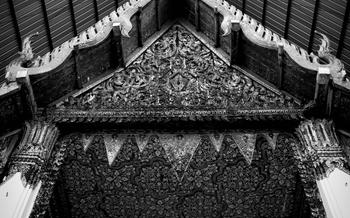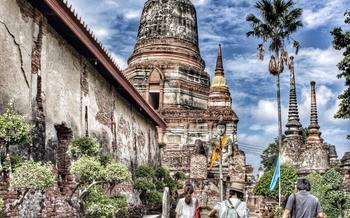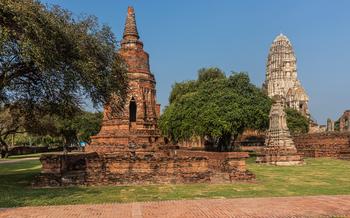
Wat Matchimawat (Wat Klang)
- History and Significance:
- Main Highlights of Wat Matchimawat
- Religious Significance
- Local Festivals and Events
- Meditation and Retreats
- Community Involvement
- Local Cuisine and Dining:
- Photography and Social Media
- Accessible Tourism
- Sustainable Tourism
- Local Guides and Tours
- Language and Communication
- Respectful Behavior
- Insider Tip: Unveiling the Secret Buddha Garden
History and Significance:
Wat Matchimawat, also known as Wat Klang, stands as a testament to the rich history and cultural significance of Songkhla. Its origins can be traced back to the Ayutthaya period, with the temple's construction believed to date back to the reign of King Rama I in the late 18th century. Over the years, Wat Matchimawat has undergone several renovations and expansions, reflecting the devotion and patronage of the local community.
The temple's architectural style exemplifies the distinctive Southern Thai craftsmanship, characterized by intricate carvings, colorful murals, and graceful stupas. The main prayer hall, known as the Ubosot, is a sight to behold, adorned with stunning murals depicting scenes from the life of Buddha and Jataka tales. These exquisite artworks showcase the artistic prowess of local artisans and contribute to the temple's unique charm.
As a prominent Buddhist temple, Wat Matchimawat holds a special place in the hearts of the local community. It serves as a center for religious ceremonies, festivals, and ordinations, attracting devotees from near and far. The temple's annual Songkran festival, held during the Thai New Year, is a particularly vibrant and colorful event, drawing large crowds who come to celebrate and pay respect to the temple.
Main Highlights of Wat Matchimawat
Wat Matchimawat boasts several captivating highlights that leave visitors in awe. The Grand Buddha statue, known as Phra Mahathat Chaloem Phrakiat, is a majestic sight to behold. Towering over the temple grounds, this impressive Buddha image exudes an aura of serenity and grandeur. Its intricate details and serene expression symbolize the temple's spiritual significance.
Another highlight is the temple's intricate carvings and murals. The walls and pillars of the main prayer hall are adorned with exquisite carvings depicting scenes from Buddhist mythology and Thai folklore. These intricate artworks showcase the exceptional craftsmanship of Southern Thai artisans and provide a glimpse into the temple's rich history and cultural heritage.
Visitors can also admire the beautifully landscaped grounds of Wat Matchimawat. The temple is surrounded by lush greenery, colorful flowers, and serene ponds, creating a tranquil and meditative atmosphere. Strolling through the gardens offers a respite from the bustling city and allows visitors to connect with the temple's peaceful surroundings.
Legend has it that Wat Matchimawat is home to a sacred Buddha image known as Phra Buddha Sihing. According to local folklore, this revered image was discovered floating on the sea and brought to Wat Matchimawat, where it has been enshrined ever since. Devotees believe that praying to Phra Buddha Sihing brings good fortune, peace, and prosperity.
Religious Significance
Wat Matchimawat holds immense religious significance as a center for Buddhist worship and meditation. The temple is home to a community of monks who dedicate their lives to studying, practicing, and teaching the Buddhist faith. Daily rituals and ceremonies, such as morning and evening prayers, chanting, and meditation sessions, are performed by the monks and open to visitors and devotees. These rituals offer a glimpse into the daily life of a Buddhist monk and provide an opportunity for visitors to connect with the spiritual essence of the temple.
The temple also serves as a place of pilgrimage for Buddhists from Thailand and beyond. Devotees come to Wat Matchimawat to seek blessings, make offerings, and pay homage to the sacred Buddha images. The temple's serene atmosphere and beautiful surroundings create a conducive environment for meditation and spiritual reflection. Visitors can join meditation sessions led by experienced monks, who provide guidance on mindfulness and Buddhist teachings. Retreats and workshops are also organized periodically, offering participants an immersive experience in Buddhist philosophy and meditation practices.
Local Festivals and Events
Wat Matchimawat is not only a place of worship but also a vibrant hub for local festivals and events that showcase the rich cultural heritage of Songkhla. During these special occasions, the temple transforms into a lively center of activity, attracting both locals and visitors from afar.
One of the most significant events is the annual temple fair, known as "Wat Klang Fair." Held over several days, the fair features a myriad of stalls selling traditional Thai food, handicrafts, and souvenirs. Visitors can indulge in delicious local delicacies, shop for unique souvenirs, and experience the vibrant atmosphere of a traditional Thai fair.
Another highlight is the merit-making ceremony, which takes place on Buddhist holidays and special occasions. During this ceremony, devotees gather at the temple to offer food and other items to the monks as a way of making merit and seeking blessings. Visitors are welcome to participate in these ceremonies and learn about the significance of merit-making in Thai culture.
Religious processions, known as "Wian Tian," are also common at Wat Matchimawat. These processions involve monks and devotees carrying sacred Buddha images or relics through the temple grounds, accompanied by music and chanting. Visitors can witness these processions and gain insights into the deep devotion and religious beliefs of the local community.
By planning their visit around these festivals and events, travelers can experience the temple's lively celebrations firsthand and immerse themselves in the vibrant cultural heritage of Songkhla.
Meditation and Retreats
Wat Matchimawat offers a serene and conducive environment for those seeking inner peace and tranquility through meditation and spiritual retreats. The temple's tranquil atmosphere, surrounded by lush greenery and the gentle chanting of monks, creates an ideal setting for self-reflection and spiritual growth. Visitors can participate in meditation sessions, workshops, and retreats led by experienced monks and teachers, who guide participants through various meditation techniques and Buddhist teachings. Whether you're a beginner or an experienced practitioner, Wat Matchimawat provides a supportive and welcoming environment to deepen your understanding of meditation and mindfulness. I had the opportunity to participate in a meditation retreat at the temple, and the experience was truly transformative. The serene atmosphere, coupled with the guidance of the monks, helped me to quiet my mind, connect with my inner self, and gain a deeper understanding of Buddhist teachings.
Community Involvement
Wat Matchimawat plays a pivotal role in the local community, extending its reach beyond religious practices. It serves as a hub for social welfare programs, educational initiatives, and community gatherings. The temple is actively involved in charity work, providing assistance to the needy and underprivileged members of the community. It organizes regular events, such as food drives and donation campaigns, to support those in need.
Additionally, Wat Matchimawat serves as a venue for various community events, traditional ceremonies, and cultural performances. These events bring together locals from all walks of life, fostering a sense of unity and preserving cultural traditions. Visitors are welcome to participate in these events, gaining insights into the local way of life and experiencing the vibrant Thai culture firsthand.
Engaging with the local community at Wat Matchimawat is a rewarding experience. Visitors can contribute to the temple's initiatives by volunteering their time or making donations. Participating in community activities or supporting local businesses helps to sustain the temple's efforts and gives back to the community.
Local Cuisine and Dining:
After exploring the sacred grounds of Wat Matchimawat, tantalize your taste buds with the delectable culinary delights that await you nearby. Embark on a culinary journey and indulge in authentic Thai cuisine at local restaurants or food stalls that are just a stone's throw away from the temple.
Songkhla is renowned for its unique culinary creations that blend the flavors of the sea with the richness of local ingredients. Don't miss the opportunity to savor the province's signature dish, "Khao Yam," a refreshing rice salad bursting with flavors and textures.
For a truly immersive experience, try "Kaeng Som Pla," a tangy and aromatic fish curry that showcases the region's love for sour and spicy dishes. Vegetarians and those with dietary restrictions will find plenty of options, such as "Pad Pak Bung," a stir-fried morning glory dish, or "Tom Kha Hed," a creamy mushroom soup infused with lemongrass and galangal.
To satisfy your sweet tooth, indulge in "Khanom Chan," a traditional Thai dessert made from mung beans and coconut milk, or "Roti Gluay," a crispy flatbread topped with sweet banana and condensed milk.
Remember to embrace the local dining culture by using your hands to eat certain dishes, as it is considered a sign of respect and appreciation for the food. Savor the flavors, engage with the friendly locals, and let the culinary delights of Songkhla create lasting memories.
Photography and Social Media
Wat Matchimawat offers a treasure trove of photo opportunities for visitors who love capturing the beauty and spirituality of their travels. The intricate carvings, colorful murals, and serene temple grounds provide a stunning backdrop for memorable photographs. Don't forget to capture the awe-inspiring sight of the Grand Buddha statue, Phra Mahathat Chaloem Phrakiat, with its golden glow and majestic presence. Share your experiences and photos on social media using relevant hashtags like #WatMatchimawat, #Songkhla, and #Thailand to connect with other travelers and inspire them to visit this hidden gem. Embrace your creativity and experiment with different angles, lighting, and composition techniques to capture the essence of Wat Matchimawat's unique charm.
Accessible Tourism
Wat Matchimawat is committed to creating an inclusive environment for visitors with disabilities. Wheelchair ramps, designated parking spaces, and accessible restrooms are available to ensure everyone can enjoy the temple's sacred spaces. The temple staff is also trained to assist visitors with mobility challenges, providing guidance and alternative routes when necessary.
To make the most of your visit, consider seeking assistance from the temple staff or using alternative routes if needed. Remember to be patient and respectful of the temple's sacred atmosphere while enjoying its beauty and tranquility.
Here are some practical tips for visitors with mobility challenges:
- Contact the temple in advance to inform them of your needs and request assistance.
- Arrive early to avoid crowds and have more time to explore the temple at your own pace.
- Use the designated parking spaces for visitors with disabilities, located near the main entrance.
- Take advantage of the wheelchair ramps and accessible restrooms throughout the temple complex.
- If you require additional assistance, don't hesitate to ask a member of the temple staff for help.
Sustainable Tourism
Wat Matchimawat is committed to preserving its sacred spaces and natural surroundings for future generations. The temple has adopted several sustainable tourism practices to minimize its environmental impact and promote responsible tourism. Visitors are encouraged to be mindful of their ecological footprint and contribute to the temple's sustainability efforts.
Reducing plastic waste is a key priority for Wat Matchimawat. Visitors are discouraged from bringing single-use plastics into the temple grounds. Instead, reusable water bottles can be refilled at designated water stations. The temple also encourages visitors to avoid using plastic bags and opt for eco-friendly alternatives such as reusable shopping bags or baskets.
Water conservation is another important aspect of Wat Matchimawat's sustainability efforts. Visitors are requested to use water responsibly, especially during times of drought. Drip irrigation systems are used to minimize water usage in the temple gardens. Rainwater harvesting techniques are also employed to collect and reuse rainwater for irrigation and other purposes.
Wat Matchimawat is also committed to energy efficiency. The temple uses energy-saving light bulbs and appliances to reduce electricity consumption. Solar panels are installed on the temple grounds to generate renewable energy. The temple also encourages visitors to conserve energy by turning off lights and fans when not in use.
By embracing sustainable tourism practices, Wat Matchimawat sets an example for other temples and religious sites in Thailand. Visitors are encouraged to be responsible tourists and contribute to the preservation of the temple's sacred spaces and natural environment.
Local Guides and Tours
Elevate your experience at Wat Matchimawat by enlisting the services of a knowledgeable local guide or joining a guided tour. These experts will provide invaluable insights into the temple's history, architecture, and cultural significance, enriching your visit with their in-depth knowledge.
Guided tours often include detailed explanations of the temple's main features, such as the Grand Buddha statue, the intricate murals, and the ordination hall. Guides can also share fascinating stories and legends associated with the temple, bringing its rich history to life.
I had the privilege of exploring Wat Matchimawat with a local guide who shared captivating tales about the temple's founding and its role in the community. His knowledge and enthusiasm deepened my understanding and appreciation for this sacred site.
Whether you prefer a private tour tailored to your specific interests or a group tour offering a lively exchange of ideas, hiring a local guide is an investment that will greatly enhance your experience at Wat Matchimawat.
Language and Communication
When visiting Wat Matchimawat, it's important to be mindful of the language barrier and cultural differences that may exist. While English is spoken by some locals, it's not widely prevalent. To facilitate communication, consider learning a few basic Thai phrases, such as "hello" (sa-wat-dee), "thank you" (kop-khun-ka/khap), and "goodbye" (la-korn). These gestures of respect will go a long way in showing your appreciation for the local culture.
If you encounter difficulties communicating, don't hesitate to use translation apps or seek assistance from English-speaking guides. These guides can provide valuable insights into the temple's history, architecture, and cultural significance, enhancing your overall experience. Remember to be patient and respectful when interacting with the monks and locals, as they may not be fluent in English.
Respectful Behavior
When visiting Wat Matchimawat, respectful behavior is paramount to ensure a harmonious and meaningful experience for all. As a visitor, it is essential to dress appropriately, covering your shoulders and knees, and avoiding revealing or overly casual attire. Maintaining silence in sacred areas, such as the main prayer hall and ordination hall, demonstrates respect for the monks and other devotees engaged in meditation or prayer. Avoid disruptive activities, loud conversations, or using flash photography to capture images, as these can disturb the serene atmosphere of the temple.
When interacting with monks, remember to wai, a traditional Thai gesture of respect, by placing your hands together in a prayer-like position and bowing slightly. Always address monks with the appropriate titles, such as "Phra" or "Luang Pho," to show reverence. It is considered impolite to touch monks or their belongings without their permission.
By observing these cultural norms and customs, visitors can demonstrate their respect for the sacredness of Wat Matchimawat and contribute to maintaining its peaceful and welcoming environment. Respectful behavior not only enriches your own experience but also ensures that future visitors can continue to appreciate the temple's spiritual significance and beauty.
Insider Tip: Unveiling the Secret Buddha Garden
Beyond the main temple grounds, there lies a hidden gem at Wat Matchimawat—a serene and secluded Buddha garden nestled amidst lush greenery. Follow a narrow path that leads you away from the bustling tourist areas and into a tranquil oasis where ancient Buddha statues rest peacefully among tropical plants and flowers.
Discover a hidden Buddha garden at Wat Matchimawat, a serene oasis with ancient statues nestled among tropical greenery. As you wander through the garden, you'll encounter various Buddha images in different postures and sizes, each with its unique story and symbolism. Take a moment to sit in silence, surrounded by the calming sounds of nature, and let the peaceful aura of the garden wash over you.
This secret garden is a place of tranquility and contemplation, inviting you to connect with your inner self and appreciate the beauty of Buddhist art and nature. It's a hidden treasure that offers a unique and serene experience, away from the crowds and distractions of the main temple grounds.





